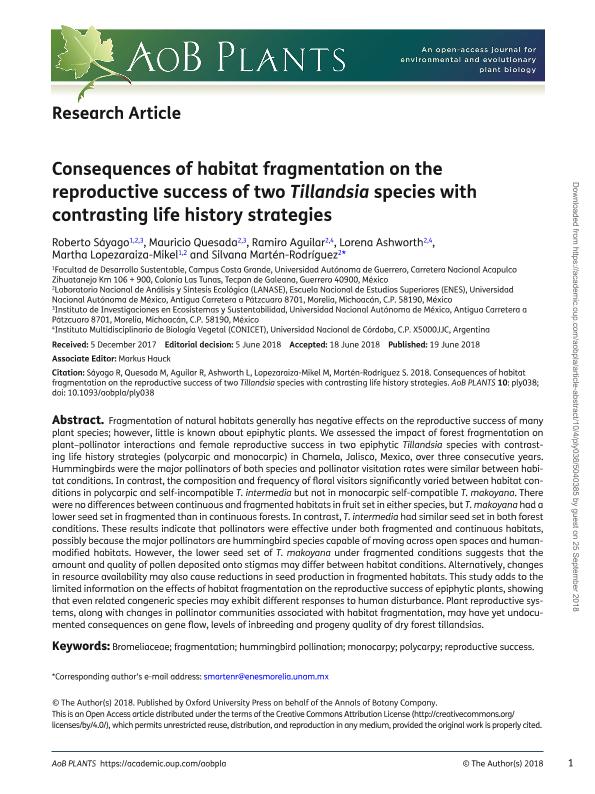Mostrar el registro sencillo del ítem
dc.contributor.author
Sáyago, Roberto
dc.contributor.author
Quesada, Mauricio
dc.contributor.author
Aguilar, Ramiro
dc.contributor.author
Ashworth, Lorena

dc.contributor.author
Lopezaraiza-Mikel, Martha
dc.contributor.author
Martén-Rodríguez, Silvana
dc.date.available
2019-11-05T16:45:19Z
dc.date.issued
2018-08
dc.identifier.citation
Sáyago, Roberto; Quesada, Mauricio; Aguilar, Ramiro; Ashworth, Lorena; Lopezaraiza-Mikel, Martha; et al.; Consequences of habitat fragmentation on the reproductive success of two Tillandsia species with contrasting life history strategies; Oxford Univ Press Inc; AoB Plants; 10; 4; 8-2018
dc.identifier.issn
2041-2851
dc.identifier.uri
http://hdl.handle.net/11336/88013
dc.description.abstract
Fragmentation of natural habitats generally has negative effects on the reproductive success of many plant species; however, little is known about epiphytic plants. We assessed the impact of forest fragmentation on plant pollinator interactions and female reproductive success in two epiphytic Tillandsia species with contrasting life history strategies (polycarpic and monocarpic) in Chamela, Jalisco, Mexico, over three consecutive years. Hummingbirds were the major pollinators of both species and pollinator visitation rates were similar between habitat conditions. In contrast, the composition and frequency of floral visitors significantly varied between habitat conditions in polycarpic and self-incompatible T. intermedia but not in monocarpic self-compatible T. makoyana. There were no differences between continuous and fragmented habitats in fruit set in either species, but T. makoyana had a lower seed set in fragmented than in continuous forests. In contrast, T. intermedia had similar seed set in both forest conditions. These results indicate that pollinators were effective under both fragmented and continuous habitats, possibly because the major pollinators are hummingbird species capable of moving across open spaces and human-modified habitats. However, the lower seed set of T. makoyana under fragmented conditions suggests that the amount and quality of pollen deposited onto stigmas may differ between habitat conditions. Alternatively, changes in resource availability may also cause reductions in seed production in fragmented habitats. This study adds to the limited information on the effects of habitat fragmentation on the reproductive success of epiphytic plants, showing that even related congeneric species may exhibit different responses to human disturbance. Plant reproductive systems, along with changes in pollinator communities associated with habitat fragmentation, may have yet undocumented consequences on gene flow, levels of inbreeding and progeny quality of dry forest tillandsias.
dc.format
application/pdf
dc.language.iso
eng
dc.publisher
Oxford Univ Press Inc

dc.rights
info:eu-repo/semantics/openAccess
dc.rights.uri
https://creativecommons.org/licenses/by-nc-sa/2.5/ar/
dc.subject
BROMELIACEAE
dc.subject
FRAGMENTATION
dc.subject
HUMMINGBIRD POLLINATION
dc.subject
MONOCARPY
dc.subject
POLYCARPY
dc.subject
REPRODUCTIVE SUCCESS
dc.subject.classification
Ecología

dc.subject.classification
Ciencias Biológicas

dc.subject.classification
CIENCIAS NATURALES Y EXACTAS

dc.title
Consequences of habitat fragmentation on the reproductive success of two Tillandsia species with contrasting life history strategies
dc.type
info:eu-repo/semantics/article
dc.type
info:ar-repo/semantics/artículo
dc.type
info:eu-repo/semantics/publishedVersion
dc.date.updated
2019-10-23T21:30:08Z
dc.journal.volume
10
dc.journal.number
4
dc.journal.pais
Reino Unido

dc.journal.ciudad
Londres
dc.description.fil
Fil: Sáyago, Roberto. Universidad Nacional Autónoma de México; México. Universidad Autonoma de Guerrero; México
dc.description.fil
Fil: Quesada, Mauricio. Universidad Autonoma de Guerrero; México. Universidad Nacional Autónoma de México; México
dc.description.fil
Fil: Aguilar, Ramiro. Consejo Nacional de Investigaciones Científicas y Técnicas. Centro Científico Tecnológico Conicet - Córdoba. Instituto Multidisciplinario de Biología Vegetal. Universidad Nacional de Córdoba. Facultad de Ciencias Exactas Físicas y Naturales. Instituto Multidisciplinario de Biología Vegetal; Argentina
dc.description.fil
Fil: Ashworth, Lorena. Consejo Nacional de Investigaciones Científicas y Técnicas. Centro Científico Tecnológico Conicet - Córdoba. Instituto Multidisciplinario de Biología Vegetal. Universidad Nacional de Córdoba. Facultad de Ciencias Exactas Físicas y Naturales. Instituto Multidisciplinario de Biología Vegetal; Argentina
dc.description.fil
Fil: Lopezaraiza-Mikel, Martha. Universidad Nacional Autónoma de México; México. Universidad Autonoma de Guerrero; México
dc.description.fil
Fil: Martén-Rodríguez, Silvana. Universidad Nacional Autónoma de México; México
dc.journal.title
AoB Plants
dc.relation.alternativeid
info:eu-repo/semantics/altIdentifier/url/https://www.ncbi.nlm.nih.gov/pmc/articles/PMC6041750/
dc.relation.alternativeid
info:eu-repo/semantics/altIdentifier/doi/https://dx.doi.org/10.1093/aobpla/ply038
Archivos asociados
